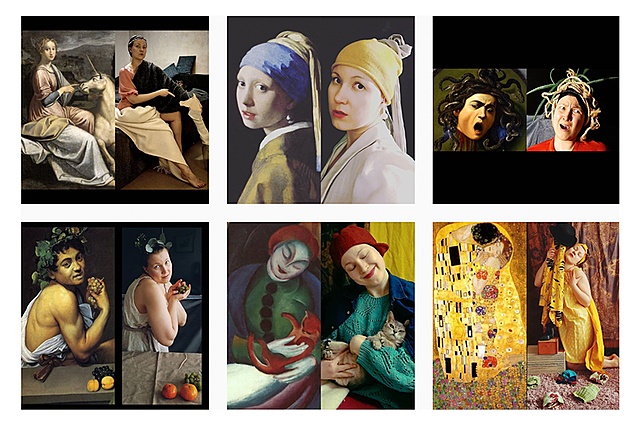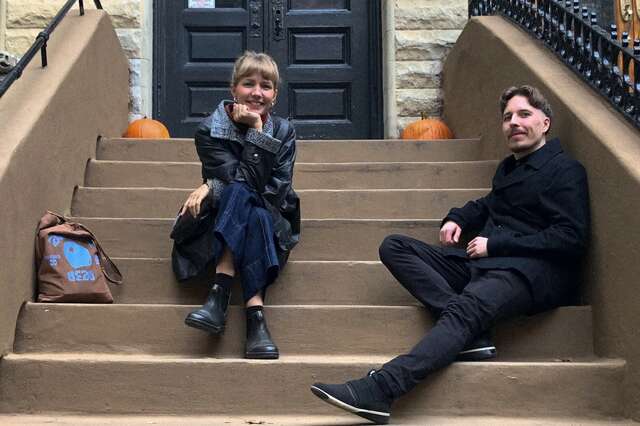Art of Exceptional Times is Born Out of Toilet Paper and Vegetables

Finns are taking part in the viral quarantine art challenge and creating their versions of world-famous art pieces on social media. Hashtag #karanteenitaidetta, promoted by Museum Card, collects together Finnish remakes.
While museums and galleries are keeping their doors closed, the most devoted art lovers have temporarily turned into makers of art. A circulating challenge in social media encourages people to recreate art history masterpieces by repurposing everyday items while staying in isolation.
Materials that have come to signify the crisis are also present in many of the real-life tableaus: toilet paper substitutes for a massive Baroque collar, and a mop becomes a Renaissance fan.
Frenzy towards homemade art appears to have started with a Dutch Instagram account Tussenkunstenquarantaine by Anneleos Officier. In a mere five weeks, Officier’s account had gained a following of 120,000. It became a collective endeavour, when Rijksmuseum in the Netherlands and J. Paul Getty Museum and the Metropolitan Museum of Art in the USA, among others, began promoting the challenge.
In Finland, the challenge has gained greater traction through Museum Card (Museokortti), which has also created a Finnish hashtag, #karanteenitaidetta, for the quarantine art pieces. Museum Card also publishes Finnish art remakes on Karanteenitaidetta Instagram account. Link to the Instagram account.
The Convalescent Is Also a Quarantine Favourite
The Finns are recreating both international and national masterpieces, from Akseli Gallen-Kallela’s works to Hugo Simberg’s. One getting numerous remakes is The Convalescent, 1888 painting by Helene Schjerfbeck. It was also an obvious choice for Elina Ylitervo when she decided to participate.
“It was basically the only option I had. The motif is suitable for the times, my son Iivari could pose for the photo and props were easily available. Besides, Helene has been my favourite artist since childhood,” Ylitervo says.
The first thing Ylitervo began to work on was the composition. When the table and chair were set in front of the bookshelf, she examined the details more closely. There had to be a red and blue object on the table, and also books in the shelf were rearranged to calm down the busy background.
“Small things matter,” Ylitervo states. “ I didn’t want to overdo the photo, though. Quarantine art needs to have a readymade feel to it.”
The entire process took about half an hour. “It had to be rather quick since the five-year-old announced in the very beginning that he has zero interest in the project.”
From Lockdown Challenge to a Design Tool
For Tiina Ikkonen, creating quarantine art has become almost like a hobby: she has already recreated multiple works of art on Instagram. Some of the works are by Ikkonen’s favourite artists, such as Klimt or Toulouse-Lautrec. Some of the works she has familiarised herself with for the challenge.
The process often begins with a specific colour or detail, or when Ikkonen realises that some object at hand would substitute for an object in a painting. The composition starts to form around the detail.
“I pay some attention to the angle of view and lighting, but these aspects are not as important for me as the humour stemming from the objects and facial expressions,” Ikkonen says. Some of her photos have been 15-minute projects, some have taken up to an hour.
“For example, Dama con l’unicorno took a bit longer. The angle of view was tricky, and also the unicorn and blankets needed more careful positioning,” Ikkonen recalls the process for the Renaissance painting remake.
The challenge has served as an art history lesson. Ikkonen has ended up browsing archives and googling art history periods and styles. Moreover, the process has also inspired her professionally. In her day job, she works with service design and makes use of different creative design methods.
“I am definitely going to adapt this as a method in my future work.”
Museum Card Has Roots in the Netherlands
Museum Card was introduced in Finland in 2015. With a one-time fee, the cardholder gets access to over 300 museums around the country for one year. Since the system came into effect, every year has been a record-breaking year for museum visits. In 2019, Finnish museums were visited 7,6 million times.
Similarly to the quarantine art challenge, Museum Card originates from the Netherlands. The Dutch Museumkaart, founded already at the beginning of the 1980s, was a reference for the Finnish application. Also, Switzerland has a national Museumspass.
Museumkaart announces on their website that 1,4 million Dutch people own the card, which means around 8 per cent of the population. Finland follows suit: by the end of 2019, approximately 265,000 Museum Cards had been sold, which means that roughly 5 per cent of Finns own the card.
Last year, Museum Card was involved in 1,4 museum visits of which the Ateneum Art Museum in Helsinki was the most frequented. It is also the place where most of the national crowd favourites popping up in the art challenge are located.
The collections are also available online. Ateneum, together with the museum of contemporary art, Kiasma and the Sinebrychoff Art Museum forms the Finnish National Gallery. During the lockdown months of March and April, the National Gallery’s online collection has doubled its visitor count compared to January and February this year, says Web Producer Taika Dahlbom.
“This is not only because of the quarantine challenge, but also due to the fact that regular art lovers are frequenting online collections to enjoy art, and teachers are using the collection as learning material. Our collection has also been noted in the media, for example in articles by the national public broadcasting company Yle and Helsingin Sanomat newspaper,” says Dahlbom.
Ateneum also houses The Convalescent. It was acquired to the collection over 100 years ago, shortly after its completion. The newly painted piece had received positive reviews in Paris. Yet, in the homeland, the reception was contradictory: although the technical execution was valued, for some, the painting felt too realistic.
Instructions on participating in the Finnish #karanteenitaidetta art challenge can be found at museot.fi website (in Finnish). All artworks entered in the contest by the end of April will be eligible for winning Museum Cards.

